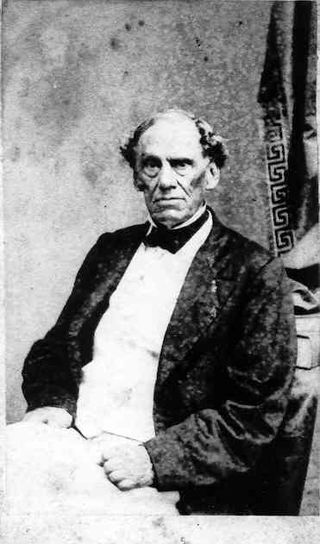
Bedford Brown was a Democratic United States Senator from the State of North Carolina between 1829 and 1840.
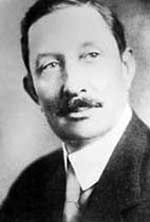
Caleb Davis Bradham was an American pharmacist, best known as the inventor of soft drink Pepsi.

The North Carolina State Capitol is the former seat of the legislature of the U.S. state of North Carolina which housed all of the state's government until 1888. The Supreme Court and State Library moved into a separate building in 1888, and the General Assembly moved into the State Legislative Building in 1963. Today, the governor and his immediate staff occupy offices on the first floor of the Capitol.

Stagville Plantation is located in Durham County, North Carolina. With buildings constructed from the late 18th century to the mid-19th century, Stagville was part of one of the largest plantation complexes in the American South. The entire complex was owned by the Bennehan, Mantack and Cameron families; it comprised roughly 30,000 acres (120 km2) and was home to almost 900 enslaved African Americans in 1860.

The Edwards–Franklin House is a plantation house in the Southern United States located in Franklin Township, Surry County, North Carolina. It was built in 1799 by Gideon Edwards and was later occupied by congressional representative Meshack Franklin, brother of North Carolina governor Jesse Franklin (1820–1821). The house was restored by the Surry County Historical Society in 1973 and is open to visitors.

Bentonville Battlefield is a North Carolina state historic site at 5466 Harper House Road in Johnston County, North Carolina. It belongs to the North Carolina Department of Natural and Cultural Resources and is the site of the 1865 Battle of Bentonville, fought in the waning days of the American Civil War. It was declared a National Historic Landmark in 1996.

Edenton Historic District is a national historic district located at Edenton, Chowan County, North Carolina. The district encompasses 342 contributing buildings, 4 contributing sites, and 3 contributing structures. It includes several buildings that are individually listed on the National Register. The Lane House, possibly the oldest surviving house in North Carolina, is owned by Steve and Linda Lane and is located within the district. Also located in the district are the Dixon-Powell House, William Leary House, and Louis Ziegler House designed by architect George Franklin Barber.

This list includes properties and districts listed on the National Register of Historic Places in Caswell County, North Carolina. Click the "Map of all coordinates" link to the right to view an online map of all properties and districts with latitude and longitude coordinates in the table below.

The William R. Davie House, on Norman St. in Halifax, Halifax County, North Carolina, is a historic house with significance dating from 1783. William R. Davie (1754–1820) was born in England. He was a Founding Father of the United States and a patriot officer of mounted troops in the American Revolution who attended the Constitutional Convention from North Carolina, served as governor of North Carolina, served as a special ambassador to France during the XYZ Affair, and served in the North Carolina legislature. The house, also known as Loretta, was built on five acres that Davie bought in 1783. It was built starting probably in about 1785. It is a large two-story, frame side-hall plan house beneath a gable roof. It has a two-story wing raised from an earlier one-story wing and a number of one-story rear additions. The house is sheathed in weatherboard and rests on a brick foundation.
Swan Ponds is a historic plantation house located near Morganton, Burke County, North Carolina. It was built in 1848, and is a two-story, three bay, brick mansion with a low hip roof in the Greek Revival style. It features a one-story low hip-roof porch with bracketed eaves, a low pedimented central pavilion, and square columns. Swan Ponds plantation was the home of Waightstill Avery (1741–1821), an early American lawyer and soldier. His son Isaac Thomas Avery built the present Swan Ponds dwelling. Swan Ponds was the birthplace of North Carolina politician and lawyer William Waightstill Avery (1816–1864), Clarke Moulton Avery owner of Magnolia Place, and Confederate States Army officer Isaac E. Avery (1828–1863).

Tate House, also known as The Cedars, is a historic home located at Morganton, Burke County, North Carolina. The core was built about 1850, and is a two-story, three bay, brick mansion with a center hall plan in the Greek Revival style. It was remodeled in the Second Empire style in 1868, with the addition of a mansard roof and large three-story octagonal tower. It was the home of Samuel McDowell Tate (1830–1897), who undertook the 1868 remodeling.

Quaker Meadows, also known as the McDowell House at Quaker Meadows, is a historic plantation house located near Morganton, Burke County, North Carolina. It was built about 1812, and is a two-story, four bay by two bay, Quaker plan brick structure in the Federal style. It features two one-story shed porches supported by square pillars ornamented by scroll sawn brackets. The Quaker Meadows plantation was the home of Revolutionary War figure, Col. Charles McDowell. It was at Quaker Meadows that Zebulon Baird Vance married Charles McDowell's niece, Harriet N. Espy.

Bellevue is a historic plantation house located near Morganton, Burke County, North Carolina. It was built about 1826, and consists of a two-story, six bay brick structure, with an original one-story wing, in the Federal style. It has a Quaker plan interior.
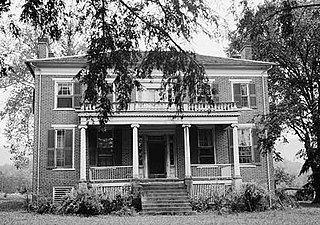
Clover Hill, also known as the Colonel Edmond Jones House, is a historic plantation house located near Patterson, Caldwell County, North Carolina. It was built in 1846, and is a two-story, five bay, brick, Greek Revival-style house. It sits on a raised basement and has a hipped roof. It features a shed porch surmounted supported by four handsome fluted Ionic order columns.
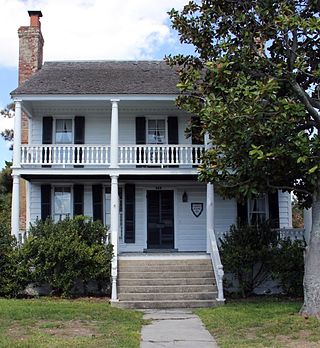
Jacob Henry House is a historic home located at Beaufort, Carteret County, North Carolina. It was built about 1794, and is a 2+1⁄2-story, four bay by four bay, Federal style frame dwelling. It rests on a high foundation of ballast stone and has a two-tier, full-width front porch. It was the home of Jacob Henry, who in 1809 entered into a debate over his right as a Jew to hold state office. Henry served in the North Carolina legislature in 1808 and 1809.

Propst House is a historic home located at Hickory, Catawba County, North Carolina. It was built in 1881, and is a 1+1⁄2-story, Second Empire style frame dwelling. It has a mansard roof, a square mansard tower, and interesting wooden ornament.

Shuford House, also known as Maple Grove, is a historic home located at Hickory, Catawba County, North Carolina. It was built in 1875, and is a two-story, three bay frame dwelling with a central hall plan. It features a two-story porch supported by four pairs of pillars.
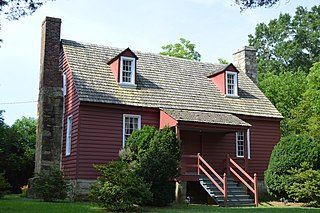
Person's Ordinary is a historic inn and tavern located at Littleton, Halifax County, North Carolina. It dates to the mid- to late-18th century, and is a 1 1/2-story frame dwelling, three bays wide and two deep, with a massive exterior stone chimney at each end. It rests on a stone cellar, and has a modified Quaker plan. The building housed an inn and tavern for stagecoach travelers into the 1830s and is associated with Thomas Person, one of the state's most important political leaders from 1760 to 1790.
Little Manor, also known as Mosby Hall, is a historic plantation house located in Warren County, North Carolina near the town of Littleton. It was built about 1804, and is a Federal style frame dwelling consisting of a two-story, five bay, pedimented main block flanked by one-story wings. It has a pedimented center bay front porch with Doric order pilasters and an older two-story rear wing, dated to about 1780.
Coleman-White House, also known as Whitesome, is a historic home located at Warrenton, Warren County, North Carolina. It was built between 1821 and 1824, and is a two-story, three bay, late Federal style rectangular frame dwelling. It has a side gable roof, entrance porch with Tuscan order columns, and exterior end chimneys. At the rear is an earlier 1+1⁄2-story frame dwelling with a gable roof. The front facade features a Palladian entrance with sidelights and Tuscan colonnettes and Palladian window on the second level.




















